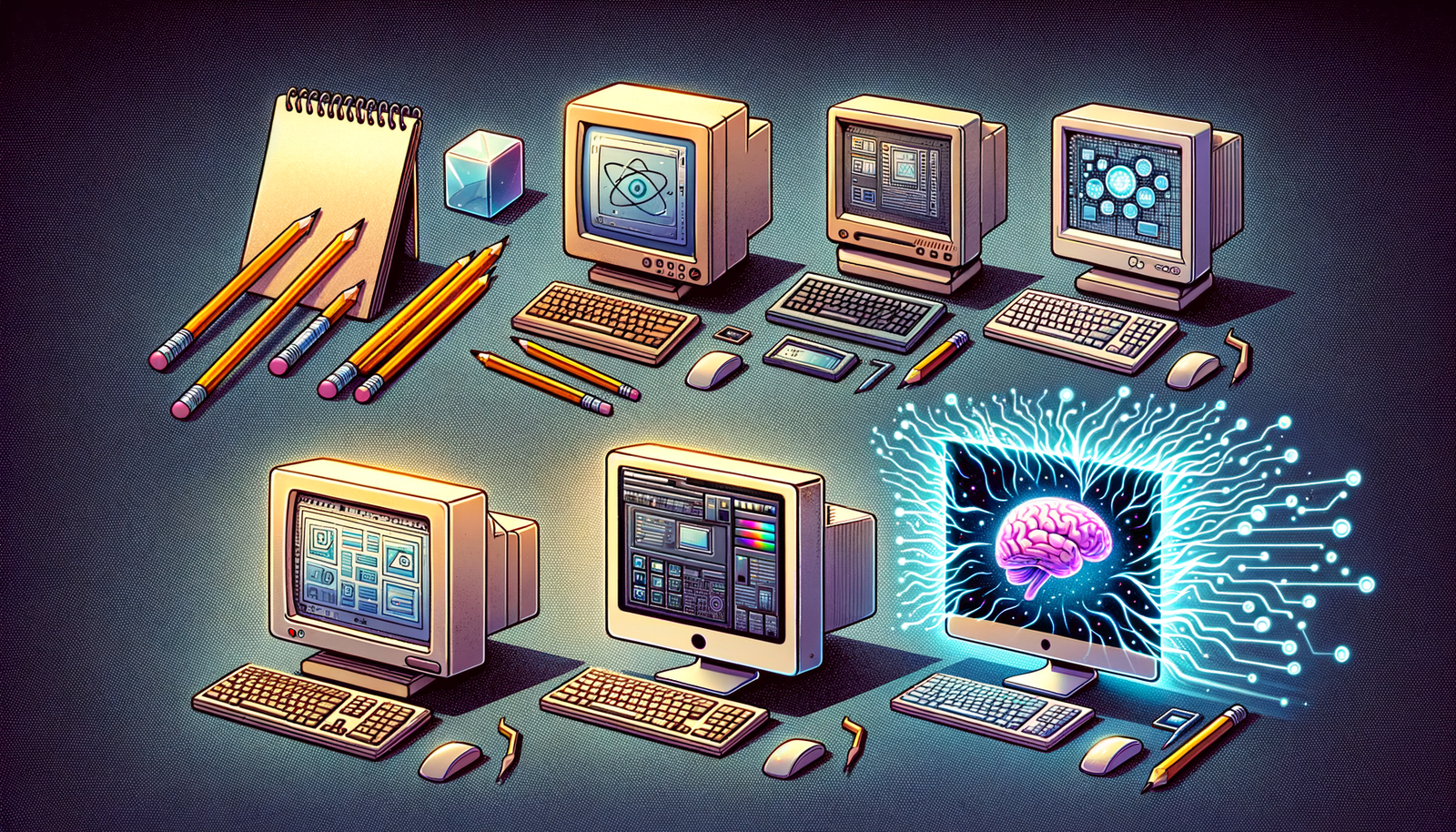Your Cart is Empty
Customer Testimonials
-
"Great customer service. The folks at Novedge were super helpful in navigating a somewhat complicated order including software upgrades and serial numbers in various stages of inactivity. They were friendly and helpful throughout the process.."
Ruben Ruckmark
"Quick & very helpful. We have been using Novedge for years and are very happy with their quick service when we need to make a purchase and excellent support resolving any issues."
Will Woodson
"Scott is the best. He reminds me about subscriptions dates, guides me in the correct direction for updates. He always responds promptly to me. He is literally the reason I continue to work with Novedge and will do so in the future."
Edward Mchugh
"Calvin Lok is “the man”. After my purchase of Sketchup 2021, he called me and provided step-by-step instructions to ease me through difficulties I was having with the setup of my new software."
Mike Borzage
Design Software History: Evolution of Design Software: From Sketchpad to AI-Driven Innovations
August 26, 2024 6 min read


Introduction to the History of Design Software
Overview of Design Software Evolution
The history of design software traces a fascinating journey from traditional manual drafting to sophisticated digital tools that are indispensable in modern engineering, architecture, and manufacturing. The transformation began with manual drafting tools like pencils, compasses, and T-squares, and evolved into advanced computer-aided design (CAD) software that can generate complex 3D models, perform simulations, and even manage entire manufacturing processes.
Design software has become a cornerstone of modern industry, allowing for higher precision, faster development cycles, and more innovative products. As technology advanced, design tools became more powerful and accessible, revolutionizing the way designers and engineers approach their work.
Early Innovations and Pioneers
One of the most groundbreaking innovations in the early history of design software was Ivan Sutherland’s Sketchpad (1963). Often referred to as the first graphical user interface (GUI), Sketchpad allowed users to interact with graphics directly on a computer screen using a light pen. This was a revolutionary concept that laid the foundation for modern CAD software.
Other early pioneers also played crucial roles in the development of design software. Patrick Hanratty, often called the "father of CAD," developed PRONTO, the first numerical control programming system, in the late 1950s. Pierre Bézier, a French engineer working for Renault, introduced Bézier curves in the 1960s, which became fundamental in computer graphics and automotive design.
Transition from 2D Drafting to 3D Modeling
The initial focus of early design software was predominantly on 2D drafting tools, which aimed to replicate the traditional drafting process in a digital format. Software like AutoCAD, introduced by Autodesk in 1982, quickly became the industry standard for 2D drafting.
As design needs grew more complex, there was a significant shift towards 3D modeling. This transition was driven by the need for more accurate and comprehensive design representations, enabling designers to create, manipulate, and visualize three-dimensional objects and assemblies. The advent of 3D modeling software marked a major leap in design capabilities, allowing for more intricate and precise work.
Core Technologies and Mathematical Models
Solid Modeling and Geometric Modeling
Solid modeling is a core aspect of modern design software, representing objects in a way that defines their volume and shape comprehensively. This contrasts with earlier wireframe modeling, which only defined an object's edges and vertices. Solid modeling provides a more complete and realistic representation, essential for engineering and manufacturing.
The evolution from wireframe to surface modeling, and eventually to solid modeling, involved significant technological advancements. Surface modeling added the ability to define an object's surfaces, making it possible to create smoother and more complex shapes. Solid modeling, which followed, incorporated volume information, allowing for accurate simulations and analyses.
Mathematical Models: Bézier Curves and NURBS
Pierre Bézier's introduction of Bézier curves in the 1960s had a profound impact on automotive design and computer graphics. Bézier curves, defined by a set of control points, allow for the creation of smooth and scalable curves, which are essential in designing complex shapes and surfaces.
Non-Uniform Rational B-Splines (NURBS) further advanced geometric modeling by offering greater flexibility and precision. NURBS are mathematical representations that can accurately describe any shape, from simple 2D lines to intricate 3D surfaces. They have become a standard in industries requiring high precision, such as automotive and aerospace engineering.
Finite Element Analysis (FEA)
Finite Element Analysis (FEA) plays a crucial role in engineering computation by enabling designers to simulate and analyze the physical behavior of a product under various conditions. FEA involves breaking down a complex object into smaller, manageable elements and solving the physical equations for each element.
The integration of FEA into design software has revolutionized engineering by allowing for more accurate predictions of how products will perform in real-world conditions. This capability helps in optimizing designs, reducing material costs, and improving product safety and reliability.
Industry Milestones and Key Figures
The Rise of Major Companies
Autodesk, founded in 1982, significantly influenced the design software industry with the introduction of AutoCAD. AutoCAD quickly became the go-to software for 2D drafting, thanks to its versatility and user-friendly interface. Autodesk's continuous innovation in CAD technology has solidified its position as a leader in the industry.
SolidWorks, developed by the company of the same name and released in 1995, had a profound impact on parametric design. SolidWorks introduced a user-friendly interface and powerful parametric modeling capabilities, making 3D design accessible to a broader audience. Its success demonstrated the growing demand for intuitive and efficient 3D modeling tools.
Pioneering Individuals and Their Contributions
Ivan Sutherland’s contributions extended beyond Sketchpad, influencing generations of computer scientists and engineers. His work laid the groundwork for the development of modern graphical user interfaces and interactive design tools.
David G. Ullman, an expert in mechanical design, contributed significantly to the development of design methodologies and the integration of computer tools in engineering education. Samuel P. Geisberg, the founder of PTC (Parametric Technology Corporation), pioneered parametric and feature-based modeling with the introduction of Pro/ENGINEER in the late 1980s, further advancing the capabilities of design software.
Integration of CAD and CAM Systems
The integration of Computer-Aided Design (CAD) and Computer-Aided Manufacturing (CAM) systems has been a critical development in the history of design software. This integration allows for seamless transition from design to manufacturing, enhancing efficiency and accuracy in production processes.
Key benefits of CAD-CAM integration include:
- Improved design accuracy and consistency.
- Reduced time and costs associated with prototyping and production.
- Enhanced ability to perform simulations and optimizations.
Despite the numerous benefits, the integration of CAD and CAM systems also presents challenges, such as the need for specialized training and the complexity of managing large datasets. However, ongoing advancements continue to address these challenges, making the integration more effective and accessible.
Modern Advancements and Future Directions
Additive Manufacturing and 3D Printing
Additive manufacturing, commonly known as 3D printing, has revolutionized the manufacturing industry. Design software plays a crucial role in this evolution, enabling the creation of intricate and customized designs that can be directly translated into physical objects using 3D printing technologies.
Key software tools and technologies driving 3D printing include:
- CAD software for creating detailed 3D models.
- Slicing software for converting 3D models into instructions for 3D printers.
- Simulation tools for predicting and optimizing the printing process.
The integration of design software with additive manufacturing technologies has opened new possibilities for prototyping, production, and even personalized medicine, where custom implants and prosthetics are designed and printed for individual patients.
Virtual Reality (VR) and Augmented Reality (AR)
Virtual Reality (VR) and Augmented Reality (AR) have emerged as powerful tools for design visualization. These technologies allow designers to immerse themselves in a virtual environment, providing a more intuitive and interactive way to experience and evaluate designs.
Applications of VR and AR in architectural and product design include:
- Virtual walkthroughs of architectural projects, enhancing client presentations and decision-making.
- Interactive product demos, allowing users to explore and interact with products in a virtual space.
The development of VR and AR technologies continues to advance, offering new opportunities for enhancing design workflows and improving communication between designers, clients, and stakeholders.
AI and Machine Learning in Design Software
The emergence of AI-driven design tools is transforming the way designers work. Machine learning algorithms can analyze vast amounts of data to identify patterns and generate design suggestions, significantly speeding up the design process.
Examples of how machine learning is transforming design processes include:
- Generative design, where AI generates multiple design options based on specified constraints and parameters.
- Predictive analytics, helping designers anticipate potential issues and optimize designs.
The integration of AI and machine learning into design software is still in its early stages, but it holds tremendous potential for enhancing creativity, efficiency, and innovation in design.
Future Trends and Innovations
Looking ahead, several trends and innovations are expected to shape the future of design software. These include:
- The continued impact of cloud computing, enabling real-time collaboration and access to powerful computational resources.
- The integration of AI and machine learning, offering more advanced tools for design optimization and automation.
- Enhanced capabilities for real-time simulation and virtual testing, reducing the need for physical prototypes.
These advancements will further expand the possibilities of design software, enabling designers to create more innovative and efficient solutions to meet the evolving demands of industries and consumers.
Conclusion
The history of design software is a testament to the power of innovation and the relentless pursuit of improvement. From the early days of Sketchpad to the advanced AI-driven tools of today, design software has undergone remarkable transformations, shaping the way we create and manufacture products.
Key milestones and technological advancements have paved the way for more efficient, accurate, and creative design processes. The ongoing importance of innovation in design software cannot be overstated, as it continues to meet future challenges and seize new opportunities in various industries.
Also in Design News

ZBrush Tip: Optimizing ZBrush Models with the Curve Bridge Brush Technique
January 15, 2025 2 min read
Read More
Revit Tip: Enhance Design Precision with Revit's Radial Array Tool
January 15, 2025 2 min read
Read More
AutoCAD Tip: Mastering AutoCAD's Revolve and Sweep Tools for Advanced 3D Modeling
January 15, 2025 2 min read
Read MoreSubscribe
Sign up to get the latest on sales, new releases and more …


